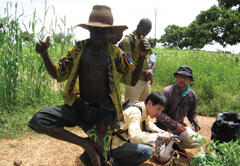Improving Sustainable Water and Sanitation Systems in Sahel Region in Africa: Case of Burkina Faso
Principal Investigator
ODA Recipient Country
Burkina Faso
Research Institutions in Japan
Hokkaido University / The University of Tokyo / Kochi University of Technology (KUT)
Research Institutions in Counterpart Country
International Institute for Water and Environmental Engineering (2iE)
Adoption fiscal year
FY 2009
Research Period
5 Years
Overview of the Research Project
Low cost and safety through a pipeless network
Burkina Faso is one of the poorest countries in the world, with 27.2% of the population at the poverty level. Many people become sick from water-borne diseases because the infrastructure for clean water and sanitation is not in place. There are many conditions needed for the water facilities that are introduced: for example, they must be able to withstand the harsh climate, and they should be easy to maintain at a low cost. The goal of this project is to create a system that does not collect wastewater in a single location but rather treats water on-site, and that separates water by use and quality rather than mixing it all together, in order to achieve a sanitary system with low costs. The new type of system to be developed to provide water and sanitation will not require a large-scale water distribution pipe network.
Bringing composting toilets to Africa to turn human waste into a source of income
Two models were proposed to match the population density and infrastructure level. In the rural area model, only the water for drinking is disinfected and filtered. Human waste is converted into fertilizer with composting toilets and the wastewater is used for irrigation, boosting income from agriculture. The urban area model uses vehicles to collect human waste, and wastewater is collected by individual communities. The technologies needed for each process are currently under development.
Photo gallery
Research Project Web site
Press Release
Links
Projects
Contact Us
Japan Science and Technology Agency (JST)
Department of International Affairs
SATREPS Group
TEL : +81-3-5214-8085
Related articles by Category
- Global-scale environmental issues
Environment / Energy
(Global-scale environmental issues)
 Kingdom of Thailand
Kingdom of Thailand
“Natural rubber seeds”, the unlimited potential hiding in natural rubber plantations
Utilization Technology of Rubber Seeds for Green Products to Mitigate Global Warming and Plastic Pollution
- Burkinafaso
Bioresources

 Burkina Faso
Burkina Faso
Promote local production and consumption of fertilizers using indigenous phosphate rock, and be free from imported ones
Project on establishment of the model for fertilizing cultivation promotion using Burkina Faso phosphate rock
- Africa
Environment / Energy
(Global-scale environmental issues)
 Republic of Zambia
Republic of Zambia
Experienced, not taught - Realizing safe water, sanitation and hygiene in Africa
Risk-based Participatory WASH Planning and Citizen-data WASH Statistics for African Peri-urban Settlements
- SDGs : Goal.6
Environment / Energy
(Global-scale environmental issues)
 Socialist Republic of Vietnam
Socialist Republic of Vietnam
From grossly contaminated river water to drinking water!
Establishing Sustainable Water Supply System Resilient to the Contamination of Drinking Water Sources























